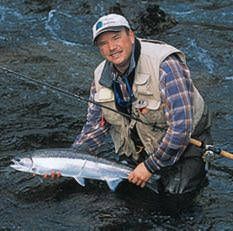West Coast Winter Steelheading
By Dennis Reid
From The Sportsman's Guide
On the West Coast of North America, winter means winter steelhead.
Officially known as Oncorhynchus mykiss, steelhead, whether the summer or winter variety, are the fish of mystique on the winter swollen rivers of Oregon, Washington, British Columbia and Alaska.

Bill Von Brendel holds up a nice steelhead caught on his 10-1/2-foot trigger-finger steelhead rod and baitcast reel. |
While the rest of the country deals with ice and snow, coastal rivers flow clear and cold between peaks laden with a due accounting of white. Arrived in freshwater as early as November, winter steelhead wait out the winter before spawning and returning as spent kelts to saltwater once again.
During this freshwater period, though reputed not to eat, winter steelhead readily snap up the fisherman's offering -- provided he has done a few things right. Among those is locating the fish. Steelhead are not difficult to catch; they are, however, difficult to find.
Focus To Find Fish
A river such as Washington's Skagit or British Columbia's Skeena Rivers, for instance, may be several hundred yards wide and finding the fish may be no easy task. But three areas deserve attention: runs, tail outs, and the heads of pools.
Runs are straight sections of river with ruffled surface water that provides cover for steelhead in the slower moving water on the bottom. Tail outs are the bottom ends of pools just before the water breaks. Fish instinctively motor through fast water (a poor place to fish) and slow to rest just above it. Heads of pools are self-explanatory.
While you can fish anytime, head out a few days after peak rains. The river will have cleared itself of clay "dust" and be lower. Go in the cold when the sky is clear and temperatures are low. This is when steelhead display peak aggressive behavior and the water is clear enough for them to see the bait. If ice forms in your line guides, you have picked the right day.
Water temperature in the mid-40s to low-50s also improves steelheading. But at all times remember they lie belly to bottom and you must dredge the deep to catch steelhead. If you are not rubbing bottom and breaking off some gear, you need to fish deeper.
Gear To Use
Two types of gear come into play in the winter: baitcast and flyrods.
Some might think flyrods an unlikely winter option, but in the right hands they are deadly. Utilize an 8-weight to 10-weight rod with a medium to heavy sink tip or shooting head. Bottom dredging requires an upstream cast and a spaghetti mend to stack extra line on the water, thus sinking it to the bottom. Perfectionists may complain that an upstream mend is preferred to stay in contact with the fly, however, getting to the bottom requires the stack approach. Thus interpretation of where fish lie is key.
Add to your store of flies with low water, heavy wire flies. No box is complete without a few purple perils and egg-sucking leeches. Consider also some of the salmon flies developed on the East Coast for Atlantic salmon. And before wading out into the river, fish the shoreline as steelhead can take up stations in remarkably shallow water.
Baitcast reels and 10-foot, 5-inch trigger-finger rods are found far more frequently on winter steelhead rivers. This is because of the ease of fishing all across the river and ease of placing the lure directly in front of the stationary steelhead.
The rig of choice features a 6-inch foam float set 4-feet to 10-feet above a simple swivel. On the minimum 15-pound mainline, a second swivel and 1-ounce to 2-ounces of pencil lead is attached, or a set of three size 4 or 5 split shots are lined up on the mainline.
From the swivel on the mainline, attach three feet of leader (maximum 15 pounds) and a Gooey Bob, Spin 'n Glo or Corkie. Beneath it complete the rig with a size 1/0 or 2/0 black steelhead hook.
Cast upstream and mend the line until the float is parallel to you, then pay out line as the float bumps its way downstream through the run you have chosen. At a wavering of the float or its disappearance, strike up hard.
Here's one final tip. Most baitcast fishermen know the frustration of an overrun, but few have tried the following technique. Instead of pulling line out as the float moves downstream, let the float pull it out, thus keeping you in contact with the lure and eliminating the bird's nest in your reel automatically.
|